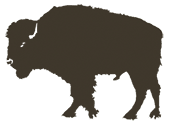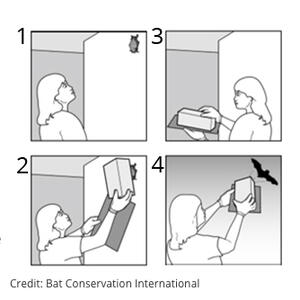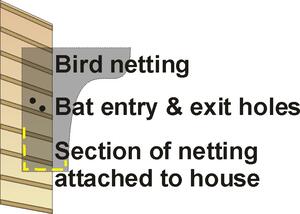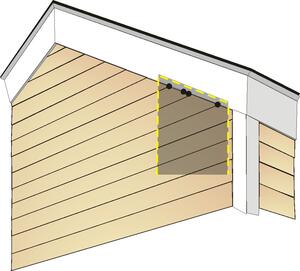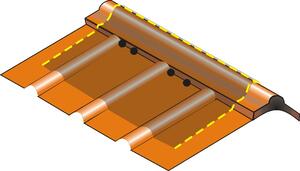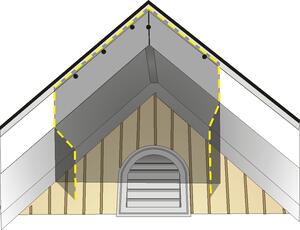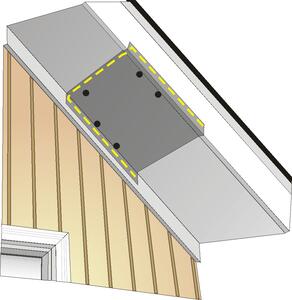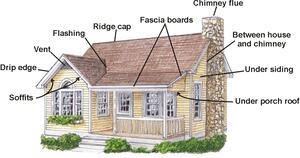Wildlife Damage Control
Nuisance Wildlife Damage Control is a program that is governed by the Kansas Department of Wildlife and Parks. It is designed to help citizens find someone who is knowledgeable in wildlife damage control. For further information click here.
Site-specific assistance is available from any district wildlife biologist (DWB) or natural resources officer (NRO) from the Kansas Department of Wildlife and Parks (KDWP). Permits authorizing lethal control measures and possession of a deer carcass outside normal deer hunting seasons may be issued by any DWB or NRO. For further information click here.
Coyotes have lived in larger cities of other states for decades, but they are a relatively recent addition to urban areas in Kansas. For more information view, Coyotes in the City.
Nuisance Wildlife Damage Control is an important part of wildlife management on your own land. For more information please click on the following link: The Importance of Wildlife Control
Nuisance Wildlife Damage Control is a program that is governed by the Kansas Department of Wildlife and Parks. It is designed to help citizens find someone who is knowledgeable in nuisance wildlife control. A list of Nuisance Wildlife Damage Control permit holders by region is available below the Regional Offices information. Please refer to the following map to find the correct region for your location:
Regional Offices
- Region 1 Office
- Region 2 Office
- Region 3 Office
- Dodge City District Office
- Chanute District Office
- Administrative Offices
- Pratt Operations Office
- Emporia Research & Survey Office
- Kansas City District Office
- County Information by Regions
Please refer to the list of the permittees in the following Regions. Note - there may be a fee charged by the permittees for this service.
Interested in becoming a Nuisance Wildlife Damage Control permittee? Please see the information below regarding the NWDC permit:
- All applicants must take the Department issued NWDC Exam.
- The course work is self-directed
- The exam is open book and consists of 100 multiple choice questions
- The exam can be taken at your closest KDWP regional or district office OR your local K-State County Extension Office.
- A minimum score of at least 80% is required to pass; a passed test is valid for 5 years
- A new NWDC Application is required each year
- The permit is valid from the date of issue through December 31st of that year
- An Activity Report is due at the end of the year with the activity done under the permit for that year.
- The permit and test are free of charge
It is recommended to review KDWP regulations on our webpage (Click Here) prior to requesting the NWDC application. The following link directs you to regulations 115-16-01, 115-16-02, 115-16-03, 115-16-04, 115-16-05, 115-16-06: Wildlife Damage Control Regulations
For further information about Wildlife Damage Management please refer to the following link:
Univ of Nebraska - The Internet Center for Wildlife Damage Management
If you have any questions, please contact the Fisheries and Wildlife Division at (620) 672-5911, or contact the Regional Office closest to you.
This manual may be printed and taken to the exam site and used during the testing. Please note: to assure you have the most recent regulations, please refer to the Wildlife Damage Control Regulations link above. This will take you directly to the most current regulations pertaining to NWDC.
This page outlines lethal control options landowners may use to address deer damage. Site-specific assistance is available from any district wildlife biologist (DWB) or natural resource officer (NRO) from the Kansas Department of Wildlife and Parks (KDWP). Permits authorizing lethal control measures and possession of a deer carcass outside normal deer hunting seasons may be issued by any DWB or NRO.
DEER MANAGEMENT GOALS
Deer are protected as a valuable public resource by state law and regulations. Provisions are authorized to allow for wise use of this resource. Deer management in Kansas is directed by long-range planning that includes input from citizens of the state as well as wildlife professionals. The goal established through this process is: “...to manage the deer population at levels consistent with existing habitat and landowner tolerance, and to provide for recreation use.”
LEGAL OBLIGATION
The Bill of Rights of the Kansas Constitution provides landowners with rights to protect their property. These rights may be applied to deer damaging crops. Both court decisions and Attorney General Opinions have shown that these rights are not without limitations. The landowner must demonstrate that deer are causing substantial damage to property. KDWP staff will consider any visible current deer damage to be substantial in this context.
Regulation K.A.R. 115-16-4 authorizes the Secretary of Wildlife and Parks to issue deer control permits. This regulation provides landowners with a legal means of controlling deer and using the meat of deer that are killed during this operation. The permits are intended to address localized problems. DWBs and COs are responsible for working with landowners in implementing the use of deer damage control permits.
OBTAINING DEER CONTROL PERMITS
- The landowner contacts the nearest KDWP office. A KDWP staff member will contact the landowner within five working days of notification of a deerdamage situation.
- The damage area will be inspected by the landowner and DWB or CO.
- If control permits are needed, an application will be prepared and damage control permits will be issued quickly.
- Each deer damage control permit is written for a specific case. When authorized, the permits will allow the landowner to kill a prescribed number of deer on the property.
- Taking antlerless deer will be emphasized during control operations.
- Permits and possession tags will be assigned to the landowner and the landowner will be responsible for the control operation.
- The landowner may issue the permits, without cost, to a designated person(s), who may act as the control agent.
- A designated agent must be a Kansas resident and must have a Kansas hunting license, unless exempt.
- Landowners will be required to follow prescribed procedures and to report on the results of their control efforts.
-
As a condition for receiving deer damage control permits, the landowner must agree to allow firearms deer hunting on their property during that year’s regular
or extended firearms deer season. - Hunter access to the landowner’s property is at the landowner’s discretion and by landowner permission.
DAMAGE CONTROL PERMITS WILL NOTSOLVE ALL PROBLEMS
A deer damage control permit is not the answer to all situations where landowners are experiencing damage. Some situations will continue to attract deer, even when many have been removed. Certain high-value crops, such as orchards and nurseries, may not be effectively protected using firearms and damage control permits. Fencing to exclude deer from these areas may be more cost effective than attempting to shoot deer as they enter the area.
DEVELOPING A MANAGEMENT PLAN
The most effective and efficient means for controlling excessive deer populations and the resulting damage they cause is through harvesting deer during established hunting seasons. This approach can place sufficient hunters in the field to harvest deer over a wide area. Regulation of permit numbers and permit types available to hunters ensures that sustained harvests will occur; however, local deer populations still may develop that detrimentally affect some agricultural producers. Deer control permits may be used to address these situations.
Deer population growth is influenced by the number of does in the population and the quality of the habitat available to them. The KDWP stresses the importance of harvesting antlerless deer in order to regulate the growth of the population.
Landowners are encouraged to cooperate with regular hunting season efforts to control deer populations, encouraging neighbors to allow a sufficient harvest on their lands. Allow legal hunters permission to hunt on your property, and encourage hunters to take antlerless deer in areas that are experiencing crop damage. Occasionally deer move substantial distances (5-15 miles) between the croplands they use in the summer and heavy cover they use in the winter. Therefore, it is necessary for landowners to work together in addressing deer damage problems. KDWP staff is available for consultation regarding the need for such cooperation.
For further information concerning deer damage control permits and other control measures, contact your local District Wildlife Biologist, Conservation Officer, or a KDWP office near you ( Locations ).
Coyotes have lived in larger cities of other states for decades, but they are a relatively recent addition to urban areas in Kansas.
Highly adaptable, coyotes often inhabit parks and undeveloped edges, but they will travel into residential or commercial areas, primarily at night. Some learn to live in highly populated and busy parts of a city.
Similar to rural coyotes, urban coyotes form packs and maintain defined home ranges. Rodents, deer (often vehicle killed), fruit and rabbits make up most of their diet, with trash and pet food generally being minimal. Vehicle strikes are the most frequent cause of urban coyote mortality.
This new top-tiered predator in the urban landscape presents unique challenges. Merely seeing a coyote is not cause for alarm, but when coyotes are present, basic precautions can prevent potential problems.
Coyotes will prey on cats and small- and medium–sized dogs, and pet predation is the most common complaint. All precautions should be exercised to protect pets.
Generally, coyotes do not attack people. In areas where coyotes are rarely removed, coyotes may lose their fear of people and become a problem that escalates when a person, usually a child, is bitten or attacked. This is rare, almost never fatal, and has not occurred in Kansas. However, people living with urban coyotes need to be aware of the risks, recognize problem coyote behaviors, and understand how to reinforce a negative association with people.
- DO NOT feed coyotes. Many coyotes that bite people have learned to associate people with food. Intentional feeding is the fastest way to create a problem. Unintentional feeding occurs when pet food is left out, fallen fruit or garden vegetables are not picked up, and trash can lids are not secured. Overgrown vegetation will create habitat for rabbits or rodents which attract coyotes.
- DO NOT leave out water sources (removing water sources also reduces mosquito populations).
- DO NOT leave pets outside unattended. Even in a fenced yard, cats and small dogs may be at risk of attack. Risk is greatest at dawn, dusk and nighttime, when coyotes are most active. A small complete enclosure within a yard is a safer option if you must leave the pet outside. Keep pets on a leash while walking.
- If you see a coyote, scare it away. Shout, throw rocks or sticks and act aggressively toward any unwanted coyote by waving your arms until it leaves. Coyotes that recognize people as a threat are less likely to become a problem.
The mere presence of a coyote is not a reason for removal. If one is removed, another will likely take its place. People should take the precautions listed in this pamphlet to keep coyotes from becoming a problem.
As coyotes become more visible during the day, spend more time in yards and begin to attack pets, removal becomes a consideration. It is up to residents, homeowners’ associations, or municipalities to determine when removal efforts are necessary. Sometimes a single coyote is responsible for the conflict and removing it may solve the problem.
When a coyote approaches people without fear, watches and shows an interest in children, attacks pets walked on a leash, or fails to flee or reacts aggressively
(growl, bark) to attempts to scare it away, removal is recommended.
Call the regional KDWP office nearest you for more information
- Region 1 Hays (785) 628-8614
- Region 2 Topeka (785) 273-6740
- Region 3 Wichita (316) 683-8069
Coyote removal can be difficult and is costly. It is often controversial, with issues arising about removal techniques and what is going to be done with the coyote.
In rural areas, nuisance coyotes are often either shot or trapped. In urban ares, coyote removal techniques require considerable skill and knowledge and should only be done by qualified individuals who have a thorough understanding of laws, regulations and ordinances. These safe techniques are well-established and based on removal of thousands of coyotes in urban settings.
There are many problems associated with attempting to relocate nuisance coyotes, making lethal control the preferred and responsible choice.
Legal methods under state law and Kansas Department of Wildlife and Parks (KDWP) regulations are often prohibited within cities (e.g., use of some traps or discharge of a firearm/bow). Traditional rural options such as hunter or trapper harvest may not be practical.
K.S.A. 32-1002 allows legal occupants and landowners, after attempting to resolve the problem using non-lethal methods, to kill animals in or around buildings or causing damage to their property.
Coyote season is open year-round. In rural areas, licensed hunters or trappers may assist complainants.
The best option for coyote removal in urban areas is usually to hire a licensed nuisance wildlife control operator (NWCO) who will remove coyotes for a fee. City and state officials typically do NOT remove urban coyotes.
INDEX
Introduction
A single bat in your house
Winter visitor
Bat colonies in your house
What kind of bats are in my building?
How did bats get into my home?
How can I help bats?
It’s not uncommon for a bat to get into your home whether that is in the attic, chimney, crevice, etc. Bats squeeze into small, tight places to seek refuge for a few nights up to several months. You are most likely to find a bat in your home in the early Spring when they have left their winter roost, mid-July to late-August when young bats are learning to fly, or late September to early-November when bats are migrating to their winter roost to hibernate. If this has happened to you, you will want to keep reading to find out what you should do and what it means for you.
Spring/Summer/Fall visitor
A lone bat can get lost and end up in your home by mistake. Depending on the time of year, the bat could be migrating or if it is very young, learning to fly. Often times, these end up with fatal results for the bat.
If you find a bat in your living space, never handle a bat with bare hands. Call the KDHE Epidemiology Hotline at 877-427-7317 to help determine if the bat needs to be tested for rabies. People found in rooms with bats that are unable to state “I know I was not bitten,” may have been exposed to rabies. This would include persons who wake up to find a bat in the room or children alone with a bat in a room. For instructions on how to safely capture a bat, please watch a video provided by the Minnesota Department of Health at: https://www.youtube.com/watch?v=NNw6hkFEtOk. If you suspect your pet has come into contact with a bat, please contact your local vet**
If you are certain that there has been no contact between the bat and people or pets, then you can try the following:
- If a bat is flying around inside your home, open all the doors and windows that exit to the outdoors and the bat might fly out. If the bat is limited to one room, close doors to other parts of the house to keep the bat from flying into another room. Bats can use their vision as well as echolocation (like a sonar system) to find their way to an open door or window. The saying ‘blind as a bat’ is a myth.
Wait for the bat to land. While wearing thick leather gloves, cover the bat with a small box or another container. Carefully slip a piece of cardboard or large envelope between the wall and the container. Slowly turn the box over, containing the bat inside. Most bats need to drop into flight from an elevated area so it’s best to place the container on its side on a tree branch or a second story deck. The bat will climb out and fly away.
- Carefully catching the bat with a butterfly net is also an option. Once captured, take it outdoors and release it. This is very difficult to do especially if the bat is flying around and healthy. It is best to wait until the bat has landed to capture it. We encourage anyone that is removing the bat from the house to use thick leather gloves to protect yourself from potential bites. Do NOT handle bats with your bare hands! Wash hands with soap and warm water once you are done handling the bat. Bats are usually not aggressive. It is likely that the animal is more afraid of you than you are of it.
- Check around your home for small holes and crevices. A lack of maintenance around the home can create small holes and crevices that bats can use. Filling in small holes and crevices around your home will prevent the bat(s) from returning.
A bat found in your home in the winter is most likely a Big Brown Bat. The bat is probably attracted to the warmth of your home or the extreme cold pushed the bat to search for a warmer area to hibernate. As long as you are sure that no bat to people or pet contact has occurred, you can try the methods listed above. Big Brown Bats are tough and able to survive colder temperature long enough to find an alternative roost. The other species in Kansas do not generally hibernate in homes as the temperature is not ideal.
Generalized Bat Activity to assist with timing exclusions.
| Bat Activity in Kansas | |
| March – Early May | Bats leave their winter roost (hibernaculum) and return to summer roosting sites. Colonies of bats form maternity (females to birth pups) and bachelor groups (male bats). |
| May – Late June | Bat pups are born. This is a very vulnerable time for mother bats and their pups. The pups cannot fly and are dependent on the mothers for transport and food (milk). Exclusion can cause higher death rates because the young cannot escape.Bat exclusion and removal is not recommended at this time. |
| July - August | Mothers are teaching pups to fly and search for insects. By August, pups can fly alone and death by exclusion is greatly reduced. |
| September - October | Bats are leaving their summer roosts and going to winter roosts.Best time for exclusion. |
| November - February | Bats are hibernating and will occasionally wake up and leave the roost on warm days in search of water and/or insects.Bat exclusion and removal is not recommended at this time. |
Finding a colony of bats in your home can be quite alarming! We recommend the following methods for exclusion:
- Exclusion method*- A small piece of mesh or netting to create a one way exit for bats that might be in an attic. It is best to exclude bats from your home in the early spring or fall, when there are no flightless young. Young bats that are not able to fly can get trapped inside which can lead to an upset mother bat and/or smelly dead bat. For more information on excluding bats from your home go to: http://www.batcon.org/resources/for-specific-issues/bats-in-buildings
- Contact local pest control. Many of these services can remove the bats. In most cases, these professionals have a special permit from KDWP that falls under Nuisance Wildlife Control. You can find more information about these permits and a list of permitted pest control companies at http://ksoutdoors.com/Services/Wildlife-Damage-Control/Nuisance-Wildlife-Damage-Control (click NWDC Permit Holders). Pest control companies that are permitted through KDWP will state which animals they can remove. Bats fall under nongame mammal removal.
- Check around your home for small holes and crevices. A lack of maintenance around the home can create small holes and crevices that bats can use. Filling in small holes and crevices around your home will prevent the bat(s) from returning.
*When trying to exclude bats from your home, go out at dusk and watch where the bats are exiting. It is also a good idea to look for evidence of guano (poop) around your home, specifically near holes and crevices. Once all the entrances/exits are identified, install a one-way door. The netting or mesh covering should be carefully placed so the bat entry and exit holes are not blocked. The netting or mesh needs to hang 2-3 ft. below the exit hole to help prevent bats from re-entering the entry/exit hole. The one way exit door should be left in place for 5-7 days to ensure that all bats have left. Keep in mind that on rainy evenings, bats will not exit. Once you are sure that all bats have successfully exited, seal all entrances the bats were using and the one-way doors can be removed. Dr. Stephen C. Frantz, senior research scientist for the New York State Department of Health, successfully designed and field tested these one-way door methods using bird netting.
What kind of bats are in my building?
Kansas is home to 15 species of bats. Some of the more common bat species in Kansas that can form colonies in your home are: Big Brown Bat (Eptesicus fuscus), Little Brown Bat (Myotis lucifugus), and Evening Bat (Nycticeius humeralis). Not so commonly found but have been documented in literature are: Northern Long-eared Bat (Myotis septentrionalis) and Tri-colored Bat (Perimyotis subflavus). To find a complete list of bats in Kansas, please visit Kansas Mammal Atlas.
How did bats get into my home?
Bats enter buildings from gaps or cracks that are 1/4" to 1/2" in diameter or larger. Some of the ways bats gain entry include:
- an unscreened attic vent
- a hole or crack under a rotted eave
- a crack or separation where the chimney meets the house
- loose or warped siding
- an open cellar hatch
- chimney
- openings where pipes or wiring met the house
- rotted window sills or a loose fitting screen
There are many ways that you can help bats. One of the first ways to help bats is to safely remove or exclude them from your home. Putting up bat houses around your yard is another step in helping conserve our bats. Bat Conservation International is a great resource to use when looking for directions on how to build your own bat house or if you need ideas on where to purchase a bat house.

